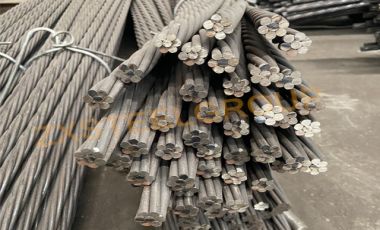
Using a 17.8mm cable bolt for coal mine support involves several critical steps, each aimed at ensuring the stability of underground structures and the safety of mining operations. Cable bolts are integral in controlling the ground in areas prone to rock falls, roof collapses, and other geotechnical hazards. Here's a detailed guide on how to effectively implement a 17.8mm cable bolt in coal mine support.
1. Understanding Cable Bolts
Cable bolts are long, flexible steel cables inserted into drilled holes in rock or coal seams to provide additional support. The 17.8mm cable bolt, which refers to the diameter of the cable, is particularly suited for use in environments where high loads need to be supported, such as in coal mines. These bolts are often used in conjunction with other ground support systems like rock bolts and mesh to reinforce underground excavations.
2. Preparation
Site Assessment:
Before installation, a thorough assessment of the site is necessary. This includes:
Geotechnical Survey: Understanding the rock strata, fault lines, and potential weak zones within the coal seam or surrounding rock.
Load Calculations: Estimating the loads that the cable bolt will need to support. This includes assessing the weight of the overlying rock or coal, as well as any dynamic loads due to mining operations.
Selection of Cable Bolt Type:
Depending on the specific conditions of the coal mine, choose the appropriate type of 17.8mm cable bolt. Common types include:
Plain Strand Bolts: Used in less demanding conditions.
Bulbed or Swaged Bolts: These have enlarged sections that provide additional anchorage, ideal for higher load conditions.
3. Drilling the Hole
The hole for the cable bolt needs to be drilled with precision:
Drill Diameter: The hole diameter should be slightly larger than the cable bolt to allow for proper grouting and ease of installation. Typically, a hole diameter of 28-32mm is recommended for a 17.8mm cable bolt.
Hole Depth: The depth of the hole should be sufficient to allow the entire length of the cable bolt to be embedded within the rock or coal seam. The depth often ranges between 1.5 to 6 meters, depending on the specific application and load requirements.
Orientation: Ensure the hole is drilled at the correct angle, generally perpendicular to the rock face or at a specified angle to intersect potential failure planes.
4. Installation of the Cable Bolt
Insertion:
Threading the Cable: The 17.8mm cable bolt is carefully inserted into the drilled hole, ensuring it reaches the full depth.
Tensioning: Once inserted, the bolt is tensioned to the required load using a hydraulic or manual tensioning device. This process pulls the cable taut, helping to compress the surrounding rock mass and enhance stability.
Grouting:
Grout Mix: A cement-based grout is commonly used. It should be mixed to the correct consistency, ensuring it can flow into the hole and around the cable without leaving voids.
Grout Injection: The grout is pumped into the hole, filling the space around the cable bolt. Grouting serves two purposes: it anchors the cable bolt securely within the rock, and it strengthens the surrounding rock by filling fractures and voids.
5. Post-Installation Considerations
Quality Control:
Load Testing: After installation, load tests should be conducted on a sample of cable bolts to ensure they are capable of supporting the required loads.
Visual Inspection: Regular visual inspections should be carried out to check for any signs of cable bolt failure or rock movement.
Monitoring:
Long-term Monitoring: Use monitoring equipment, such as extensometers or load cells, to measure ongoing movement and stress in the supported area. This helps in assessing the effectiveness of the cable bolts over time.
6. Safety Considerations
Safety is paramount when working in coal mines. Ensure all personnel involved in the installation are trained in the correct procedures and are aware of the potential hazards. Proper ventilation must be maintained during drilling and grouting to avoid the buildup of dust and fumes.
7. Maintenance and Follow-up
Routine Checks: Regularly check the tension and condition of the cable bolts. Re-tensioning may be required over time as the ground settles.
Replacement: In cases where cable bolts are damaged or have lost their effectiveness, they should be replaced promptly to maintain ground stability.
The use of a 17.8mm cable bolt in coal mine support is a critical aspect of ensuring underground safety and stability. By following the steps outlined—preparation, drilling, installation, and ongoing maintenance—mining operations can effectively manage the risks associated with underground excavation.
Address: No. 1738, 17th Floor, No. 1 Mall, Shangdu Road, Zhengdong New District, Zhengzhou City, Henan Province, China
Email: zxminesupport@zxsteelgroup.com
Tel: +86-199 3712 3680
© 2020 ZXSTEELGROUP